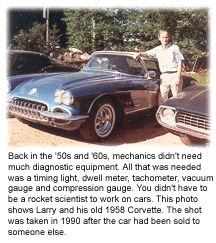
W hen I was a young man, I remember my dad saying something to the effect that working on cars wasn’t exactly rocket science. He was right. In the days of carburetors and contact point ignition systems, a mechanic didn’t need much diagnostic equipment. All you needed was a timing light to check spark timing, a dwell meter to set the points, maybe a tachometer to check idle rpm, a vacuum gauge to check intake vacuum (for leaks, valve spring and timing problems) and a compression gauge to check the cylinders. You didn’t have to be a rocket scientist to work on cars.
The OPEC oil embargo and energy crisis combined with growing concerns over the environment changed all that in the 1970s. Exhaust Gas Recirculation (EGR) and other add-on emissions controls appeared in 1973, unleaded gas arrived, and catalytic converters became standard equipment in 1975. Then came feedback carburetion and computerized engine controls in 1980-’81.
Rocket science had arrived.
When I was a teenager in the 1960s, I was much more interested in the space program than I was cars. Don’t get me wrong. I had an old Corvette that I spent every dime and most of my spare time working on. Even so, my career goal was not to be an auto mechanic (as technicians were called in those days) but a rocket scientist. I wanted to work for NASA and shoot for the moon.
 In those days, the United States and the former Soviet Union were locked in a fierce competition to see who would get to the moon first. In 1960, President Kennedy set a goal of landing a man on the moon by the end of the decade. We beat both the deadline and the Russians and landed a man on the moon in 1969. A few moon missions later and the whole thing came to a sudden and abrupt end. Congress pulled the financial plug on the space program.
In those days, the United States and the former Soviet Union were locked in a fierce competition to see who would get to the moon first. In 1960, President Kennedy set a goal of landing a man on the moon by the end of the decade. We beat both the deadline and the Russians and landed a man on the moon in 1969. A few moon missions later and the whole thing came to a sudden and abrupt end. Congress pulled the financial plug on the space program.
At the time, I was a college boy studying to be an aerospace engineer. When the space program had the rug yanked out from under it, a lot of rocket scientists suddenly found themselves unemployed. It was obvious there would be few job opportunities in rocket science for the foreseeable future. I changed majors and ended up with a degree in Journalism with a minor in Engineering.
Fast forward several years.
When I finally landed a job as a technical editor with an automotive magazine, the technology I had grown up with was obsolete. Computers, electronic fuel injection and emissions testing had arrived, all of which required much more sophisticated diagnostic equipment and troubleshooting techniques.
Rocket science had arrived.
By the 1980s, the Powertrain Control Modules (PCMs) in most cars were making more calculations per second than the computers NASA used to successfully guide and control the Apollo spacecraft on their missions to the moon. All NASA had to accomplish was to plot the right trajectory and keep three astronauts inside a sealed spacecraft alive while they went to the moon and back.
By comparison, the automotive computer had a much more daunting task to perform. The automotive PCM had to (1) protect the entire planet from environmental disaster by limiting the amount of pollution in the exhaust, (2) maximize fuel economy to comply with government Corporate Average Fuel Economy (CAFE) standards, and (3) be reliable and (4) capable of self-diagnosing faults. The automotive PCM also had to go the distance all by itself (no redundant backup computers).
Fast forward to today.
The latest generation of automotive PCMs are running 32-bit operating systems and using Controller Area Networks (CAN) to communicate with numerous modules throughout the vehicle. Variable valve timing, throttle-by-wire, anti-lock brakes, traction control and stability control have all become commonplace.
The electronic content in automobiles has been growing exponentially for the past decade and shows no signs of letting up. Electronics now control about 86% of everything that happens in a typical vehicle today. Some luxury vehicles have as many as 50 control modules for the engine management, transmission, climate control, ABS, air bags, power accessories, and onboard navigation and entertainment systems.
The new hybrid electric vehicles, such as the Toyota Prius, Honda Insight, Civic and others, add yet another layer of complexity – and are light-years ahead of the simple cars and mechanical components I worked on in my youth. I never thought that someday it would take the equivalent of a rocket scientist to diagnose and repair emissions and engine performance problems in late-model vehicles.
Fortunately, today’s state-of-the-art scan tools make that job a much easier task. Still, it takes a lot of training and experience to understand how all these systems operate and how to use a scan tool effectively to sort out helpful data from useless data. It also helps to know how to read waveforms on a digital storage oscilloscope, and more importantly how to compare and analyze waveforms to identify sensor problems and circuit problems. You also have to know something about OBD II systems monitors enable criteria that can turn on the Malfunction Indicator Lamp (MIL) and set a Diagnostic Trouble Code (DTC).
Yes, it’s the space race all over again. Only this time around, the acronyms are different and the race is between all the new technology that’s going into new vehicles and the diagnostic tools and know-how that’s needed to keep those vehicles running. The only way to win this kind of race is to keep yourself and your tools up-to-date – otherwise you’ll end up like the Russians, left behind and out in the cold.








